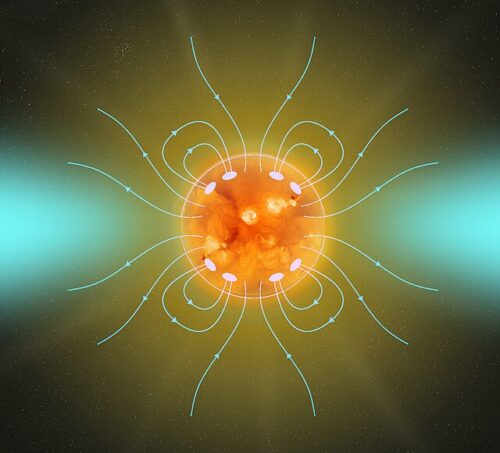Stars are born spinning. As they age, they slow down due to an effect called “magnetic braking.” Imagine you’re spinning around in a chair, slowly winding down because of friction. This is how stars undergo magnetic braking—but instead of friction, they slow down because of their own magnetic fields and stellar winds, in turn weakening the star’s magnetic field.
Scientists thought that magnetic braking occurred at a constant rate throughout a star’s lifetime. Recently, however, in a study published in The Astrophysical Journal Letters, a team of researchers, including Yale professor Sarbani Basu, made a fascinating discovery: magnetic braking actually loses efficiency over time, causing middle-aged stars to rotate faster than previously thought. To study at what point in a star’s life magnetic braking weakens, Basu and her collaborators measured the age, rotation rate, and magnetic fields of several stars, including the star 51 Pegasi (abbreviated 51 Peg). The researchers chose 51 Peg because it plays an important role in the history of the search for worlds beyond our Solar System. After all, it was where astronomers discovered the first exoplanet around a star similar to the Sun.
Calculating the rate of magnetic braking of 51 Peg required a multi-step process. Basu first determined the age, mass, and radius of 51 Peg by analyzing stellar oscillations. She compared this approach to listening to the vibrations of a bell to figure out what it’s made of. Other team members in Colorado gathered data from the Large Binocular Telescope Observatory in Arizona to successfully map the magnetic fields of 51 Peg using a technique called Zeeman-Doppler imaging. Given this data, the amount of magnetic braking can be measured by calculating how much torque is applied to the star to slow down its spin. Basu found that 51 Peg’s magnetic braking isn’t as strong as we thought, meaning that stars can lose their magnetic fields faster than originally believed.
This new understanding of stellar magnetic braking changes the way we think about the habitability of exoplanets, which is a measure of the potential for a planet to sustain life. “The question is, had there been an Earth-like planet around 51 Peg, would it be a nice [enough] star that we could potentially have a habitable planet, or is the star so active that it’s going to be dangerous?” Basu said. The closest star to the Sun, Proxima Centauri, has a rocky planet called Proxima b. Although Proxima b is the perfect distance away from Proxima Centauri, this star has strong magnetic activity, making it unlikely that the planet would be habitable—strong stellar winds and dangerous mass ejections would strip away its atmosphere. The decreased efficiency of magnetic braking means that the magnetic fields of the stars get weaker as they age. This suggests that magnetically active middle-aged stars could be promising locations to search for planets hiding extraterrestrial life.
Image courtesy of Wikimedia.

